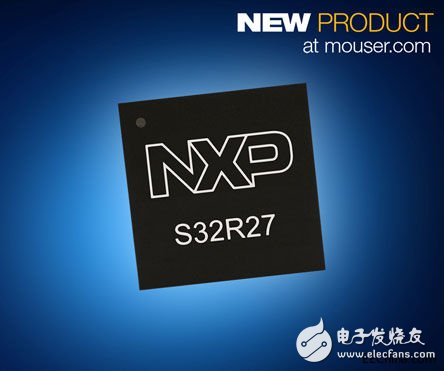Mouser Electronics is now stocking NXP Semiconductors' S32R274 radar microcontroller. Combining signal processing acceleration with a multi-core architecture, the S32R274 delivers up to four times the performance of industrial and automation applications up to the high-performance computing requirements of modern beamforming and fast chirped radar systems.

The NXP S32R274 radar microcontroller from Mouser Electronics offers a versatile solution for general software tasks and automotive bus interfaces. The S32R274 uses radio frequency (RF) front-end technology (RFCMOS or BiCMOS) to provide designers with a scalable solution for ultra-short, short, medium and long range radar systems.
This family of microcontrollers features four Power Architecture cores (the secure core uses the e200Z4 32-bit CPU and the dual compute core uses the e200Z7 32-bit CPU) for superior power performance, integration, security and reliability. They also feature 2 MB of flash memory with ECC, 1.5 MB of SRAM with ECC, and a Signal Processing Toolbox (SPT) for radar signal processing acceleration. To protect memory, the S32R274 provides 24 entries for each core memory protection unit, as well as data and instruction bus system memory protection units and register protection.
The S32R274's security features include a cryptographic security engine for advanced security management, a password and device security module that supports monitoring and lifecycle management, and tamper-proof logging. The S32R274 is ISO 26262 SEooC automotive safety standard with a safety rating of up to ASIL-D and an AEC-Q100 Grade 1 certification, making it an ideal solution for advanced driver assistance systems (ADAS).
Kadena (KDA) is a hybrid blockchain network and smart contract platform that aims to unite public applications, private blockchains, and other interoperable chains in one place, driving traffic to the high-bandwidth computer at the heart of the Kadena public chain. Kadena`s mining algorithm is Blake2S, which supports ASIC mining.
Kadena is a blockchain network and smart contract token aiming to bring together both public applications and private blockchain.
The coin solves various problems that prevent blockchain adoption on a bigger scale. The protocol enables businesses and developers to make transactions and share information across many networks.
The Coin is actually on the grid to reduce users` experience in the network. Ethereum users experience a lot of network congestion which results in high gas fees.
A few changes have come into Kadena mining. A proof of work blockchain uses PACT to create smart contracts in the hidden gen. Therefore you need to know the following before mining Kadena. PACT is an intelligent contract language serving the needs of the blockchain community.
1.You Need an Excellent Mining Hardware
To mine efficiently, you will require suitable mining hardware. Kadena uses ASIC miners. But, unfortunately for Kadena miners, CPUs and GPUs are not usable. Furthermore, ASIC mining receives support from the Blake2S algorithm.
2.Make Sure You Have a Kadena Wallet Address
You will need a Kadena wallet address to receive and monitor your profit. F2pool also makes the distribution of the revenues to every user daily at 2KDA. The Kadena node wallet is a perfect wallet where you can receive your mined KDA. all you need to do is install it, click receive, and have a new wallet address.
You will need to configure your Asic Miner to a mining pool server for your hashrate and profit to be recorded and monitored.
3.Start Mining
After all the setting is done, your miner will be ready to work. Make sure you enter your wallet address and click on the go button to receive your revenue.
Kda Miner,Antminer Ka3 166Th,Bitmain Antminer Ka3 166Th,Antminer Bitmain Ka3
Shenzhen YLHM Technology Co., Ltd. , https://www.hkcryptominer.com
